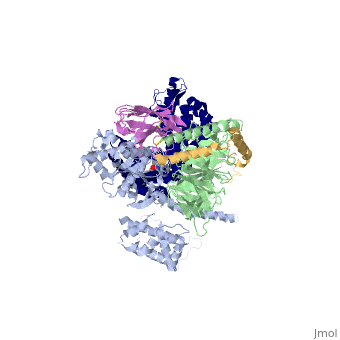| Structural highlights
Function
GNAS2_BOVIN Guanine nucleotide-binding proteins (G proteins) are involved as modulators or transducers in various transmembrane signaling systems. The G(s) protein is involved in hormonal regulation of adenylate cyclase: it activates the cyclase in response to beta-adrenergic stimuli.
Publication Abstract from PubMed
G protein-coupled receptors (GPCRs) are responsible for the majority of cellular responses to hormones and neurotransmitters as well as the senses of sight, olfaction and taste. The paradigm of GPCR signalling is the activation of a heterotrimeric GTP binding protein (G protein) by an agonist-occupied receptor. The beta(2) adrenergic receptor (beta(2)AR) activation of Gs, the stimulatory G protein for adenylyl cyclase, has long been a model system for GPCR signalling. Here we present the crystal structure of the active state ternary complex composed of agonist-occupied monomeric beta(2)AR and nucleotide-free Gs heterotrimer. The principal interactions between the beta(2)AR and Gs involve the amino- and carboxy-terminal alpha-helices of Gs, with conformational changes propagating to the nucleotide-binding pocket. The largest conformational changes in the beta(2)AR include a 14 A outward movement at the cytoplasmic end of transmembrane segment 6 (TM6) and an alpha-helical extension of the cytoplasmic end of TM5. The most surprising observation is a major displacement of the alpha-helical domain of Galphas relative to the Ras-like GTPase domain. This crystal structure represents the first high-resolution view of transmembrane signalling by a GPCR.
Crystal structure of the beta2 adrenergic receptor-Gs protein complex.,Rasmussen SG, DeVree BT, Zou Y, Kruse AC, Chung KY, Kobilka TS, Thian FS, Chae PS, Pardon E, Calinski D, Mathiesen JM, Shah ST, Lyons JA, Caffrey M, Gellman SH, Steyaert J, Skiniotis G, Weis WI, Sunahara RK, Kobilka BK Nature. 2011 Jul 19;477(7366):549-55. doi: 10.1038/nature10361. PMID:21772288[1]
From MEDLINE®/PubMed®, a database of the U.S. National Library of Medicine.
See Also
References
- ↑ Rasmussen SG, DeVree BT, Zou Y, Kruse AC, Chung KY, Kobilka TS, Thian FS, Chae PS, Pardon E, Calinski D, Mathiesen JM, Shah ST, Lyons JA, Caffrey M, Gellman SH, Steyaert J, Skiniotis G, Weis WI, Sunahara RK, Kobilka BK. Crystal structure of the beta2 adrenergic receptor-Gs protein complex. Nature. 2011 Jul 19;477(7366):549-55. doi: 10.1038/nature10361. PMID:21772288 doi:10.1038/nature10361
|

